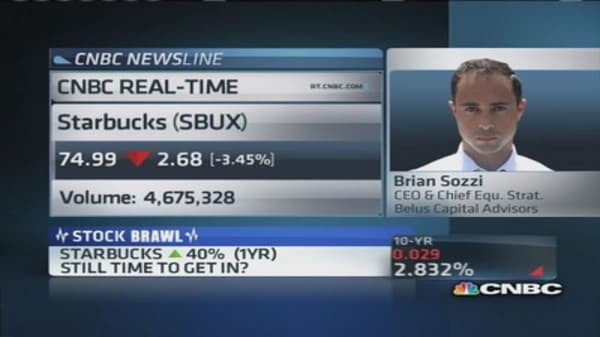So from the outside looking in, it would appear that Wall Street is very right by expecting fiscal year 2014 earnings of $2.68 per share, above the top end of management's $2.55-$2.65 per share guidance, and removed from more cautious comments on sales trends on the fourth-quarter earnings call a couple months ago. In fact, in chatting with contacts on the Street, the mood is that Starbucks is on track to replicate its fiscal year 2013 playbook of earnings close to 20 cents per share more in fiscal year 2014 than its initial guidance. Wow, now THOSE are whisper numbers!
(Read more: Tracking the slow death of American icon Sears)
All I can say to the preponderance of evidence is this: not so fast, Jack. Let's brush aside for a second that Howard Schultz on January 6 basically sounded the alarm bell to every uber-bullish Wall Street analyst covering the company by acknowledging Starbucks was "not immune" to the fundamental shift in how people are increasingly using technology to consume goods and services. Hey, best I could tell you are presently unable to have an iced Trenta Redeye home delivered by an Amazon drone while searching for a shirt on the Macy's iPad at home. Where I think there is a problem developing at Starbucks is with its drive to be everything to everybody at all hours of the day.
The company has put itself in this interesting position by aggressively expanding its menu size, leading to what I have called "McDonald's Syndrome." This is a syndrome where a public company lusting for that next layer of growth jam packs its operations with new products and services that reduce efficiency, in effect raising the risk of missed sales opportunities. How do I know this may be forming at Starbucks? Unbeknownst to but a couple close team members, I have been undercover in various Starbucks locations the past two months closely watching and observing the processes of employees behind the counter and how consumers are interacting with the Starbucks brand.
(Read more: Customers paying the price after Target breach)
Line madness, part 1 & 2
Check out this crazy long line at Starbucks. (Watch the vine video.) This may seem normal during rush hour but here's the thing — this was during a traditionally slower off-peak period for Starbucks. Great to see this traffic in light of new food and drink offerings, for sure. But, the crowded experience during an otherwise calm period actually caused people to leave. Sorry Starbucks regular, your secret time to fly in and out of the store for a caffeine fix refill is gone. That experience, in my opinion, hurts the perception of the brand, and sends a person off to find an alternative coffee source.
Notice what happens with this really long line. (Watch the vine video.) The line extends to the drink- and food-server station from beyond the cash register, almost crowding out those trying to add sugar and milk at the dedicated condiment station. That is evidence of the aforementioned McDonald's Syndrome.
(Read more: Why Best Buy may be a bad buy: strategists)
Poor oven positioning
These are the Starbucks high-powered mini ovens that are used to heat La Boulange products and assorted wraps. Look how they are positioned too far away from the register, an issue I found at many Starbucks locations. (Watch the vine video.) That positioning raises the number of steps a worker has to take to satisfy an order, in the process removing valuable facetime interacting with consumers and attending to the needs of other guests. End result: slower lines, rushed orders, order mistakes, unhappy customers, free drink giveaways that swipe at margins.





